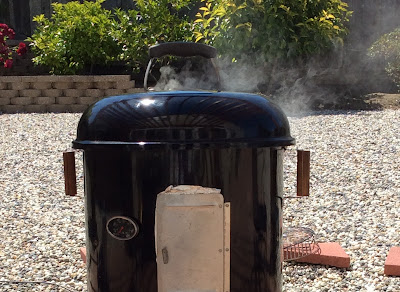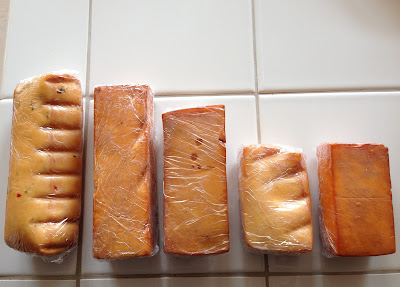| Different cheeses to be smoked |
When people think of smoked food, they think of barbecuing brisket, pork ribs, Boston butt (for pulled pork), etc. Little do people realize that you can smoke cheese as well. I don't know anyone who dislikes cheese unless you're lactose intolerant, but if you love cheese, then certainly you'll love smoked cheese. Grilled cheese sandwiches, nachos, and cheese/crackers get that much better when using smoked cheese. It's amazing how smoke can totally enhance regular cheese. You're probably wondering how you can smoke cheese without melting it. That's why you have to cold smoke it. Cold smoking is a technique in which you still produce smoke with very little or minimal heat. When you smoke food, you're both cooking it and adding some smoke flavor to it. With cold smoking, on the other hand, you're just adding the smoke. Cheese must be cold smoked, but you can also cold smoke nuts, salt, butter, etc.
| Cheeses (clockwise): cheddar, Gouda, Monterey Jack, pepper jack |
Smoked cheese can sometimes be expensive, so I tend to smoke cheddar, gouda, monterey jack, and pepper jack cheese. Other softer cheeses like brie and mozzarella are prone to melt easily, so I stay away from those. I've tried smoking manchego (a cheese from Spain), but the flavor of the manchego seemed to conflict with the smokiness and is better suited unsmoked. I find that cheddar (particularly sharp) and Gouda lend themselves very well for smoke. Definitely experiment with other cheeses though like Swiss, Havarti, Colby, Parmesan, Edam, etc. I'd actually be interested in smoking blue cheese and put it in a salad or spread it in a sandwich or burger. Whatever cheese you choose to smoke, be sure to remove any red cheese wax or any hard rind which may prevent smoke from adhering to the part of the cheese you're going to be consuming.
| My charcoal smoker: a modded Brinkmann (ECB) and Weber Jumbo Joe hybrid |
The smoker I have is a modded Brinkmann (aka ECB or El Cheapo Brinkmann) and Weber hybrid. I use the base and lid from a Weber Jumbo Joe charcoal grill and combine that with the barrel of a Brinkmann to make a smoker that Voltron would be proud of. It basically works the same way as the Weber Smokey Mountain would when combined. For my smoker I left the top vent halfway open and the bottom vent slightly less that half open.
| Filling a tube smoker with hickory wood pellets |
The primary source of fuel that I use for cold smoking is Traeger wood pellets from Costco. Burning these wood pellets produces the smoke needed in much the same way that burning wood chips or chunks would. You can get pellets of commonly used wood for bbq like hickory, apple, cherry, oak, alder, pecan, mesquite, etc. My personal preference is hickory because I like the strong flavor of hickory versus the more milder fruit woods. The smell and taste of hickory to me is the flavor of bbq, but any wood would do. The reason why I use pellets is because they're easy to put inside a smoker tube. Once the tube is filled with pellets, you can then light one end of it using a butane torch (I actually use a Weber lighter cube since I don't have a butane torch). The wood pellets would slowly burn kind of like a candle. The smoker tube I have is 12 inches in length and that usually burns and produces smoke for 3 to 4 hours which is plenty sufficient to impart some smokiness onto your cheese. In cold smoking, you're not using any charcoal at all, so only burning these wood pellets produces very little heat.
| My water smoker in action and chugging away |
The usual temperature for smoking meat is 225° to 250° F. With cold smoking, you want to keep the temperature low. Somewhere below 100° is ideal. In today's smoke, the temperature actually went up to 110° or so, but that was still ok. Even though you're producing very little heat by using a smoker tube, you'd be surprised that the temperature in your smoker can still go up and be enough to totally melt cheese. You may still need to take additional steps to further lower the temperature.
| Cheese engulfed in smoke and soaking it in |
Even though grilling season and barbecuing usually occurs in the summer months, it's common for people to only cold smoke during the winter time when it's already cold out. Cold smoking in the summer may be difficult at best, but certainly feasible. Not only that, but it's advantageous that your smoker or grill is under some shade and not exposed to the hot sun. Another way to keep the smoker environment cold is to put a pan of water and/or ice to further keep the temperature down. This acts as a heat sink to absorb heat, so that the cheese doesn't get any of it. Since my modded smoker is a water smoker, there's already a pan for water and ice. If you just have a regular charcoal or gas grill or any other smoker, then you can just put a disposable pan filled with water and ice somewhere inside. When you smoke meat, you're not supposed to check on it because doing so will let out valuable heat. When you cold smoke cheese, it's actually to your advantage to open the lid every so often to let that heat out. You definitely don't want that heat to warm up the inside of your smoker.
| Optimal cold smoking temperature: 100° F or less |
As mentioned previously, I smoke cheese for about 3-4 hours or until the wood pellets in the smoker tube are all burned out. Half way through the smoking process, I'll usually flip the cheese over in case certain sides of the blocks of cheese aren't getting as much smoke. This isn't necessary, but I just do it anyway. Once the cheese is done smoking, I let it rest at room temperature for a bit (say 20-30 minutes). During this time, I pat it down with a paper towel to remove any excess oil on the surface. Then, I wrap it in plastic wrap (or better yet vacuum seal it if you have one of those vacuum sealers), put in a zip lock bag, and place it in the refrigerator. I wait at least a week before eating it in order to allow the smoke flavor to permeate from the surface of the cheese to the inside. The longer you wait, the better it'll taste, but I've been known to eat smoked cheese as early as the next day. Whenever I smoke cheese, I smoke a lot of it anyway. It'll take me at least a week just to eat one block of cheese, so by that time the other blocks will have already matured.
| Smoked cheddar (top) and pepper jack (bottom) cheese |
| Smoked Monterey jack (top) and Gouda (bottom) cheese |
In the end the cheddar held up well to the heat. The Monterey jack, pepper jack, and Gouda cheeses melted slightly that they got deformed a bit and lost a little bit of its shape, but didn't totally melt and make a mess at the bottom of my smoker. The smoking process darkens the cheese surface giving it a tanned or dark orange tint to it after being exposed to smoke (see picture below). The Gouda and Monterey Jack cheeses were nearly indistinguishable based on only the color. I would recommend cutting different cheeses similar in color a different shape prior to smoking in order to be able to tell what cheese is what. I like serving smoked cheese with crackers anytime I host a party at my house. People always seem to like the cheese platter consisting of smoked cheeses, but I also like to give it to friends, family, and coworkers. It definitely makes a great gift for any cheese lover.
| Note the discoloration of the (Monterey jack) cheese surface exposed to smoke |
| Smoked cheese wrapped and ready for refrigeration: (L-R) pepper jack, extra sharp cheddar, Gouda, Monterey Jack, sharp cheddar |





























